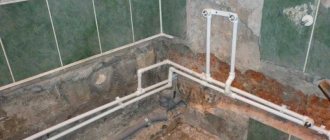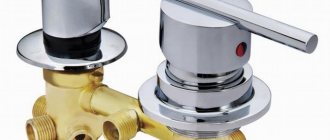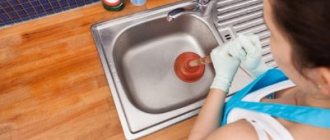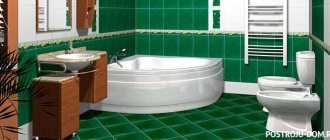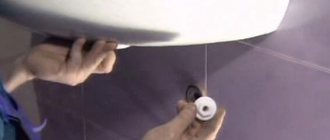The problem of unpleasant sewer smell in the bathroom is familiar to almost every person. Most often it comes from the drain, where used water and waste are washed away. This phenomenon causes a lot of trouble - the disgusting aroma quickly spreads not only throughout the bathroom, but also throughout the apartment, so that it becomes quite difficult to stay in it.
This will cause a lot of trouble. Experts are confident that such a malfunction of plumbing threatens not only to spoil the mood, but also be dangerous to human health.
Is it due to the water seal?
High humidity, heat, an abundance of organic matter, and limited air exchange are ideal conditions for putrefactive processes to occur in drain pipelines. The gases generated as a result, in order to disrupt the atmospheric eco-balance of the apartment, can only find some kind of leak in the system. Contaminants can also create stench if they accumulate in traps in close proximity to drains.
The influence of a water seal on the entry of odors.
Reason No. 1. Siphon contamination
Fat particles, hair, and cosmetic residues captured by the flow of warm water cool down once they get inside the drain pipes. They turn into a sticky mass that settles on the walls of the siphons of shower trays, sinks or bathtubs. Accumulated sewage creates a favorable environment for the growth of bacteria, gradually making the passage of waste more and more difficult. At the same time, the harmful emissions of decomposing organic matter are not retained by the water seal, since a lot of them settle above the bend of the siphon.
Elimination and prevention: Remove and thoroughly clean the siphon from accumulated deposits, then rinse using dishwashing detergent. Install in place, ensuring tight connections. To prevent or reduce the rate of sewage sedimentation, you should regularly use special means for cleaning and disinfecting household sewer systems.
Reason No. 2. Dehydration of the water seal
Sewer odor can seep into the room through a dehydrated plumbing fixture trap. There are several reasons for this:
- The prolonged absence of the apartment owners leads to evaporation of the water seal fluid. In the summer heat, this can happen quite quickly - in just a couple of weeks.
- The bend of the corrugated siphon pipe was broken. Sometimes, over time, it stretches and straightens, so water does not stay in it.
- The water seal fluid is sucked into the sewer. Typically, characteristic bubbling sounds are heard.
Elimination and prevention: firstly, it is enough to simply pour a little water into a siphon that has stood for a long time and has dried out. This will end the problem with the stench.
Advice! Before leaving for a long time, close the drain hole with a rubber stopper. A glass of sunflower oil poured into it will also help. But after returning, you will have to thoroughly rinse the drain fittings with a plumbing solution (alkali or soda solution) to break down grease, as well as with plenty of hot water.
Secondly, carefully inspect the siphon to see if it contains a sufficient amount of liquid. It is enough to straighten the corrugation or tighten it with clamps, giving it an S-shape.
The liquid must completely cover the internal section of the pipe. 1. Siphon made of S-shaped corrugation. 2. Bottle siphon. 3. Bath siphon.
Thirdly, it may be necessary to resolve issues with neighbors. After all, it was their actions that could lead to a situation with constant water suction from the water seal. This happens if the decompression conditions in the drain pipe are violated - it was simply removed on the top floor without installing an aerator (air valve). Or the valve is installed, but its capacity is not designed for operation in an apartment building.
The solution to the problem is to restore the drain pipe with access to the roof or select a high-quality, high-performance aerator.
Reason No. 3. Violation of the tightness of the drain system
Defects (cracks, ruptures, punctures, etc.) may appear on the siphon parts or outlet pipes. Sometimes depressurization of the joints of plumbing fittings occurs, which begin to leak or allow sewer fumes to pass through.
Elimination and prevention: Repair maintenance of drain elements comes down to their inspection and replacement of damaged parts. If a leak is detected at a dismountable connection, then sometimes it is enough to tighten it or replace the elastomer sealing gasket in it. To ensure that problems with detachable siphon joints are avoided in the future, some plumbers recommend initially installing all gaskets on sanitary silicone.
Sealing sewer joints
Often pipes begin to leak at the joints. Work needs to be done to correct the problems. Using fum tape will help eliminate leaks temporarily. Therefore, it is better to use a sealant.
Silicone
One of the best types of sealant will help hold the pipes together firmly. They will last a long time if the joints are lubricated with silicone. The compositions do not shrink and retain their properties even with sudden temperature changes.
Acrylic
Although such sealants have low elasticity, they will last a long time. Their advantage is their ability to repel water. They adhere to joints at any temperature.
Silicone-acrylic
Sealants are used not only at pipe joints. They “treat” cracks, chips, and seal seams in areas of the plumbing system.
Polyurethane
Apply sealant to the damaged area with a spatula. When it dries, the system is started. Polyurethane sealant takes paint well.
We eliminate foreign odors in the bathroom using an integrated approach
The most likely causes of unpleasant “odors” in bathrooms associated with the operation of water seal fittings are discussed above. However, in order to make the right decision on how to get rid of unwanted odors, the search for their source should be approached comprehensively:
- Of course, it all starts with an inspection of the communication elements. In addition to siphons, all sewer lines should also be subject to detailed study. Leaks are detected, most often appearing at the docking points. If droplets of water are detected, the joint should be cleaned of dirt and sealed with silicone sealant. It is better to perform the operation with the connection connector. But if it is impossible to disassemble/assemble it, as a last resort, process it only from the outside.
- If a crack is found on the plastic drain pipe, it is best to replace it with a new one. If the metal pipe has a small crack, a temporary clamp with a rubber gasket will help.
- It is possible that the sewer lines are made with slight slopes. This leads to stagnation of water and accumulation of decomposing organic sediments. The problem can be solved by altering the drain system in compliance with installation rules.
- The washing machine hose will not prevent fumes from escaping from the drain pipes if it is positioned incorrectly. Manufacturers of household appliances recommend forming an S-shaped bend on the flexible hose, and placing its upper attachment point at a height of 50-80 cm. In addition, installing a special siphon for connecting washing units is encouraged.
- The source of the odor is sometimes the result of constant moisture accumulation under the bathtub or sink. Over time, fungal formations grow on it, which saturate the air with their harmful spores and gaseous waste products. To eliminate them, it is necessary to thoroughly rinse the affected surface with a disinfectant solution, such as chlorine. Then dry and treat with an antifungal agent. To prevent the accumulation of moisture under plumbing fixtures, the seams where they adjoin the walls must be completely filled with sealants.
- Check the cabinet on which the washbasin is installed. It can also cause mustiness in the room. By drilling additional holes in its walls, you can normalize air circulation under the sink. This ensures quick removal of moisture from the bedside table.
- A careful inspection of the room may reveal that the smell comes from a laundry basket, a rag lying around, or an old soft toy lying under the bathtub, etc.
Operating principle of a fan pipe
All liquids in the sewer move by gravity. This means that the only driving force is gravity. If there is no hole in the vertical riser for air to pass through, the liquid will not flow down and will stop. To eliminate this situation, all risers have access to the roof and are open at the top. The outer part located on the roof surface is called an aerator. It ensures the removal of biogas and ventilation of the system. The incoming air does not allow the water to stop under the influence of its own elasticity. In addition, a hole in the top allows sewer gases to escape.
The section of the riser that faces the roof is called the fan pipe. The quality of operation of the entire riser and branches to apartments in a high-rise building or private house largely depends on its condition. If the drain pipe is clogged or blocked, the operation of the system is at risk of blockages that contribute to the accumulation of harmful gases.
Sewer pipe - responsible for ventilation and pressure in the sewer pipe, one of the important elements of the system
The autonomous sewage system of a private house, the main element of which is a septic tank, also requires a drain pipe. During the process of settling and processing wastewater in tanks, a large amount of gases is released, which is removed through aerators on the tanks themselves and on the roof of the house.
Eliminate odor in the toilet or shared bathroom
A toilet installed in a bathroom can also have a significant impact on the air quality in the room, which is especially noticeable when its normal functioning is disrupted. Therefore, in an integrated approach to finding and eliminating the causes of unpleasant “odors,” we do not forget about inspecting the plumbing of the latrine.
- The first step is to check the integrity of the toilet outlet and the place where it connects to the sewer outlet. Perhaps there is a leak that requires replacement of the sealing collar or treatment with a sealing compound. The event will not cause any particular difficulties if the plumbing fixture is connected to the sewer using a corrugated connector. But if the interface is rigid, then the toilet will first have to be dismantled.
- Inspect the drain tank - where it sits, where the water supply hose is connected, and the condition of the tank. Cold water, especially in winter, causes condensation to form on the outer surfaces of the tank. Collecting into drops, it flows under the toilet, forming puddles. Constant dampness favors the development of mold and bacterial colonies.
Removal of unwanted microflora is carried out with detergents and disinfectants. In addition, good ventilation is a good way to prevent moisture stagnation.
- It also happens that behind communication pipes in an inaccessible place there is a forgotten rag or sponge. Once saturated with water, they slowly rot, poisoning the atmosphere of the bathroom.
Preventive measures
In order not to get rid of the smell of sewage in the bathroom every week, and to forget about this problem forever, you should adhere to the following preventive measures:
- Do not forget to regularly clean the ventilation in the bathroom to ensure proper air exchange.
- The sink openings must be covered with special nets to prevent debris from entering.
- Check sewer system connections monthly for leaks.
- Ensure good ventilation and ventilation of the bathroom.
- Once a month, check the serviceability of the water seal and, if necessary, remove debris and grease from it.
- If possible, buy high-quality plumbing fixtures and update them as they wear out. Modern models are well protected from stagnation and rust, and with proper installation of the system, you can forget about such troubles for several years.
Checking the ventilation
A musty smell in a bathroom or toilet can be caused not only by a faulty drainage system, but also by insufficient ventilation. When circulation is disrupted or air is renewed, water vapor is removed slowly, which turns out to be critical for the microbiological balance of a room with high humidity.
It is important to ensure quick drying of the bathroom, especially after completing hygiene procedures or drying clothes. If existing ventilation ducts with gravity draft cannot cope with this task, then it is recommended to install a forced ventilation system.
Smell from the ventilation duct
Sometimes the ventilation duct itself becomes the source of the stench. For example, if some small animal (bird, mouse, rat) is stuck in the ventilation shaft. If you cannot remove the carcass of a dead animal on your own, then you should seek help from professional stove makers, call the dispatcher at the housing office or another company involved in home maintenance. To speed up the resolution of the issue, it is better to submit a written collective application together with your neighbors.
Before the application is completed, the ventilation duct opening will have to be closed. An ordinary plastic film is suitable, which is used to cover the grille from its inside or outside with sizing with tape or masking tape.
Gentle prevention of waste systems
Supporters of everything environmentally friendly, as well as owners of private houses with autonomous treatment plants, are recommended to choose modern bio-friendly preparations or folk remedies to prevent sewage pollution. If such biochemistry does not seem too cheap to you, then to get rid of the bad “aroma” from sewers:
- pour 2 tablespoons of salt into the drain hole of a bathtub or shower stall for an hour. Then rinse with plenty of cold water;
- 1-2 tablespoons of baking soda should be regularly poured into sink siphons that gradually become overgrown with fatty deposits in bathrooms, and especially in kitchens. Leave everything overnight, and in the morning rinse thoroughly with hot water;
- An effervescent reaction of a mixture of soda and vinegar gives a good preventive effect. First, 4 tablespoons of regular soda are poured into the drain, after which half a glass of vinegar is poured there. As a result of abundant gas release, as well as the effect of soda and acid on mud deposits, sewer pipes are cleaned. After the reaction is complete, wait a little and rinse the system with hot water.
Home methods for cleaning pipelines
If there are obstacles inside the pipeline, the water in the water seal will not be renewed, and the filling drains will begin to decompose, emitting an unpleasant odor.
In order to neutralize the blockage, certain means are used:
- Salt with soda. The method is used for preventive purposes and to perform gentle cleaning of the walls of the sewer pipe. To dissolve hair and impurities, you need to use more effective chemicals.
- Vinegar with soda. This product effectively clears away fat deposits. After pouring, after 3 hours you need to pour boiling water (1-1.5 l) into the hole. Treatment with soda can be alternated with the use of a plunger.
- Using a plumbing cable. Using this product you can remove dense blockages with large debris. The use of cables in corrugated joints is not recommended, because a sharp nozzle can damage the walls.
- Use of chemicals. To remove blockages, they use certain products: Tornado, Bagi Potchan and Mr. Muscle, Chirton powder, liquid Mole, DEBOUCHER Active and Synergetic, Sanfor, Chistin, Tiret and Sanox gels.


